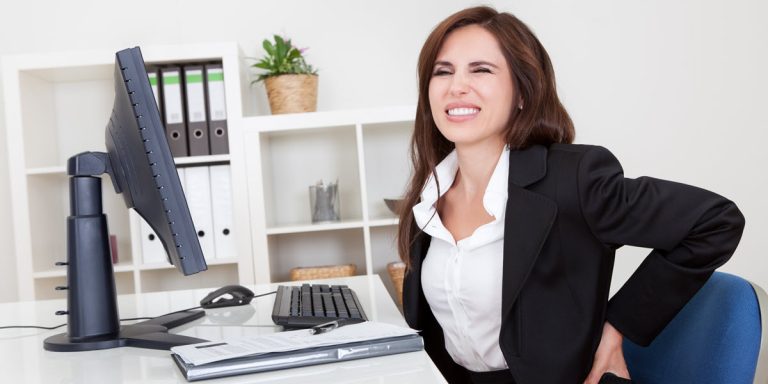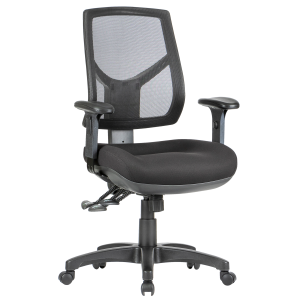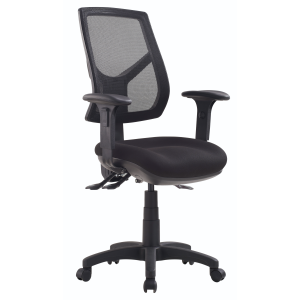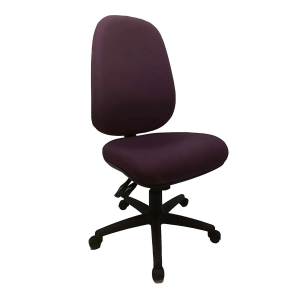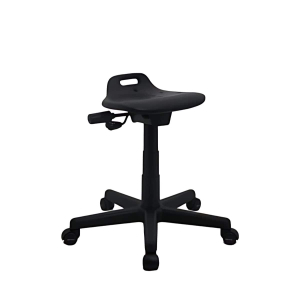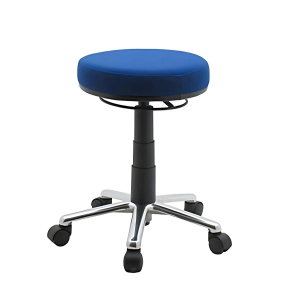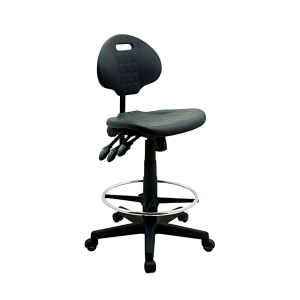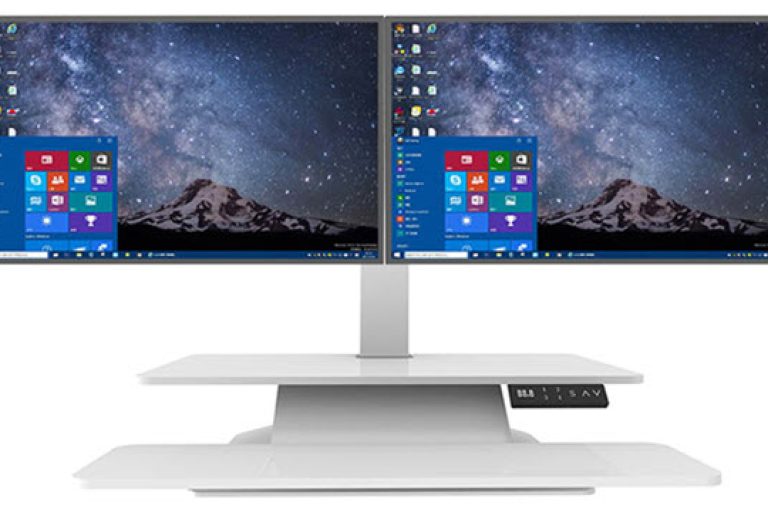Back pain, especially in the lower back, is a common affliction among Australians. This is particularly true for those who work in offices and other areas that require a lot of sitting throughout the day.
In many cases, the cause of this back pain is poor posture while sitting at a desk.
Without adequate support for the lower back, also called the lumbar spine, many workers begin to slump after a long day of staring at a computer screen. This causes the natural curve in the lower back to flatten.
Over time, this can create sensitive pressure points along with a range of other serious health issues, which feel painful after sitting for a while.
While it is true that lumbar support for office chairs has come a long way over the decades, delivering better support than the chairs of the past, ergonomic chairs are not one-size-fits-all.
Chair designers do their best to provide adequate lower back support for chairs for the widest possible range of people, but it is virtually impossible for a single chair style to work for everyone. You may need additional lower back support for your office chair if you’re hoping to create an ergonomic office layout. Fortunately, you have a variety of options available to you.
Have you often asked yourself these questions?
- Why is my back hurting after extended periods of sitting?
- How can I reduce chances of having a sore lower back?
- Do I have enough lumbar support on my office chair?
- How to prevent bad backs from poor sitting posture?
- How can I improve my posture while sitting?
Well, you most likely have an issue with your current back support. Here’s what you need to know.
HOW YOU SHOULD BE SITTING WHILE AT YOUR DESK
While sitting at your desk, it can be very tempting to relax your body, cross your legs or slouch over. Although this may be very comfortable for short periods, you will do some severe damage to your spine over time that may cause serious health issues.
So it is important to create a good posture habit by setting up your work area to compliment your perfect posture.
Then after completing these steps, you will have a better idea if you need a whole new chair with better lumbar support or just a couple of accessories to help improve your posture.
Here are our steps:
- Alter your armrest, so your arms can rest comfortably on them with a 90-degree angle in your elbows.
- Adjust the height of your chair so your armrests are in line with your desk, meaning you can easily use your keypad while still resting your elbows on the armrest.
- Your feet should lay flat on the floor with your knees at a 90-degree angle. If your feet don’t touch the ground, you could invest in an adjustable footrest.
- Your computer screen should be directly in front of you, meaning you don’t need to lower your gaze and create a strain on the back of your neck.
Once you have taken these steps to alter your office setup to help you sit up straight at your desk, it should become apparent how much lumbar support you need to compliment the curve in your spine and if you require any additional accessories for sitting at your desk.
Why You Might Need to Boost Your lower back support for your Office Chair?
Everyone’s body is shaped differently, and this includes the lumbar curve at the base of the spine. If your lumbar curve is deeper than average, it is unlikely that a standard office chair will provide the back support you need.
The same is likely true for car seats.
However, some chair styles may increase your need for supplemental support. For example, high-backed chairs often push the upper back and shoulders forward, forcing the lower back away from the support of the back of the chair. Styles with deep seats present a similar problem.
The Problem with Inadequate Back Support
When you aren’t getting enough lumbar support from your office chair, you can begin to slump or slouch as the day progresses.
Check in with yourself throughout the day to evaluate your posture. If you find yourself hunching forward, giving your back a curved shape, your back is likely not getting enough support.
As you hunch, your spine bends, putting a lot of pressure on your vertebrae, the discs between them, and the ligaments and muscles that hold them together.
How to Tell if Your Chair Support Is Lacking?
To find out if you need more lumbar support for your office chair, try this simple trick.
Roll up a small towel and place it between your lower back and the back of the chair at about waist-height. Take note of how your posture and comfort level differ with the towel. If you notice that you are slouching less and that your back feels less pain or discomfort, your chair needs greater support.
While some slumping can be attributed to the person, in many cases, it is more the fault of the chair itself.
Of course, you do have control over your posture, but it is extremely difficult to maintain a neutral, relaxed spine position when your office chair is actively pushing it out of alignment.
Options for Improving Your Office Chair’s Lumbar Support
Fortunately, you have several options to help improve your posture and minimise lower back pain, including:
A footrest under your desk may not seem like it is related to back pain, but you’d be surprised how effective this small change can be.
By raising your feet above the ground, you encourage yourself to sit up straighter, bringing your spine closer to its natural curve. Depending on the severity of your back problems and the inadequacy of support in your chair, you may need to use additional measures as well.
Remember that trick we mentioned above to help you determine whether you need additional back support?
Well, you can use that same rolled-up towel to boost your support. This is a great, short-term option, like if you are attending a meeting in a conference room and aren’t sitting in your own chair.
However, without securing the towel to the back of the chair, it will likely move around throughout the day as you shift your weight. You’ll have to readjust it frequently to ensure it is still providing support where you need it most.
There are many pillows available on the market to help boost lumbar support for office chairs. However, like the chairs themselves, lumbar cushions only come in specific sizes.
If you can find a size and style that is just right for you, that may be the solution to your problems, but you may have to go through several before you find the right fit. Not only that, but your needs may change throughout the day as you switch up your sitting style, resulting in the need for several pillows to match your changing needs.
Option 1 – Add a Footrest
A footrest under your desk may not seem like it is related to back pain, but you’d be surprised how effective this small change can be.
By raising your feet above the ground, you encourage yourself to sit up straighter, bringing your spine closer to its natural curve. Depending on the severity of your back problems and the inadequacy of support in your chair, you may need to use additional measures as well.
Option 2 – Roll Up a Towel
Remember that trick we mentioned above to help you determine whether you need additional back support?Well, you can use that same rolled-up towel to boost your support. This is a great, short-term option, like if you are attending a meeting in a conference room and aren’t sitting in your own chair.
However, without securing the towel to the back of the chair, it will likely move around throughout the day as you shift your weight. You’ll have to readjust it frequently to ensure it is still providing support where you need it most.
Option 3 – Use a Lumbar Pillow
There are many pillows available on the market to help boost lumbar support for office chairs. However, like the chairs themselves, lumbar cushions only come in specific sizes.If you can find a size and style that is just right for you, that may be the solution to your problems, but you may have to go through several before you find the right fit. Not only that, but your needs may change throughout the day as you switch up your sitting style, resulting in the need for several pillows to match your changing needs.
Option 4 – Customise Your Fit with Air Lumbar Support – Our Recommendation
Air Lumbar Support is your BEST OPTION as it enables you to adjust the support as often as you like.
This way, you can get exactly the support you need at all times.
This type of cushion can be installed right inside the back of your office chair with a convenient bulb at the base to allow you to inflate and deflate the pillow. This will provide you with unparalleled lumbar support to ease your lower back pain and help you stay focussed while you work.
ORDER AIR LUMBAR SUPPORT ONLINE
Our inflatable air lumbar support pillows are available on nearly all of the office chairs we have on offer here at arteil.
Adjusting the inflation and support level is remarkably easy, so your lower back is in for a real treat. You’ll be amazed how much easier it is to maintain your focus throughout the day when back pain isn’t constantly sapping your energy.
Reach out to our team today to learn more about this customisable back support. We’ll help you select the perfect office chair to meet your needs.
TYPES OF OFFICE CHAIRS THAT OFFER LUMBAR SUPPORT
Ergonomic Chairs
An ergonomic office chair is usually more expensive than a standard desk chair but offers many benefits and extensive back support. They have features that allow you to customise the lumbar support’s height and depth to create a bespoke curve that supports the natural curve in each individual’s spine.
They are also designed so an individual can adjust the height of the ergonomic chair so they can comfortably lay their feet flat on the ground while having a 90-degree angle in their knees. These chairs should also contain adjustable armrests so you can rest your elbows on them at again a 90-degree angle, relieving any stress on your neck and shoulders.
Mesh Office Chairs
Office chairs made with mesh take into account the lower back’s curvature when designing the backrest structure. The chair’s backrest is designed in a smooth waterfall-like shape, helping to gently release back pain as you sit back as the mesh almost moulds your back while sitting.
Kneeling Chairs
A kneeling chair may look a bit odd initially but can relieve back pain and improve posture when used correctly. These chairs are designed only to be used for short periods and may cause damage if repeatedly used for prolonged lengths of time.
People who use a kneeling chair may experience benefits such as easing back pain, strengthening core muscles, and compression within the spine.
24/7 Chairs
24/7 chairs are designed for people who spend most of their days and time sitting in a chair. These chairs are made with high-quality materials to create a high-level durable chair to be used for long periods without quickly wearing.
These specific chairs for long hours are made to be comfortable with soft materials like leather, memory foam, and mesh so you can sit for long periods without feeling the need to stand up and walk around.
They are similar to ergonomic office chairs in that their backrest, armrests, seat height, headrest, and lumbar support are all completely customizable.
FAQ’s
What is lumbar support?
Lumbar support is something that is placed onto your lower back to support the natural curve of your lumbar spine. It can range from a small cushion or a folded towel to a specially made chair insert or belt. Lumbar support is necessary as if your spine remains unsupported while sitting for long periods, the spin can begin to flatten as you slouch, causing back pain and severe health issues.
Where should lumbar support be?
The lumbar support should be placed into the curvature of your lower back. This area varies in each person as everyone’s spine is shaped slightly differently and can vary in height, length, and depth. What works for one person may not work for you. So when choosing and placing lumbar support, you should first examine your own body to see where the dip in your spin is as well as how long and deep it is.
What is the best office chair for back support?
There is no one-size-fits-all when it comes to back support. When looking at office chairs, your spine’s natural curve when sitting up straight should match the curve of the chair.
Ergonomic Chairs are many peoples best option for office chairs as they can be easily customised to many different spine shapes and needs. However, there may be better lumbar support options for some people, depending on their back support needs.
How to wear a lumbar support belt?
If you are struggling with back pain, your doctor or physio may recommend a lumbar support belt. The support belt should be placed on the curvature of your lower back and then wrapped and secured around the front of your belly. The belt should be tight enough to feel the support of the belt but not so tight that you feel any difficulties breathing.
